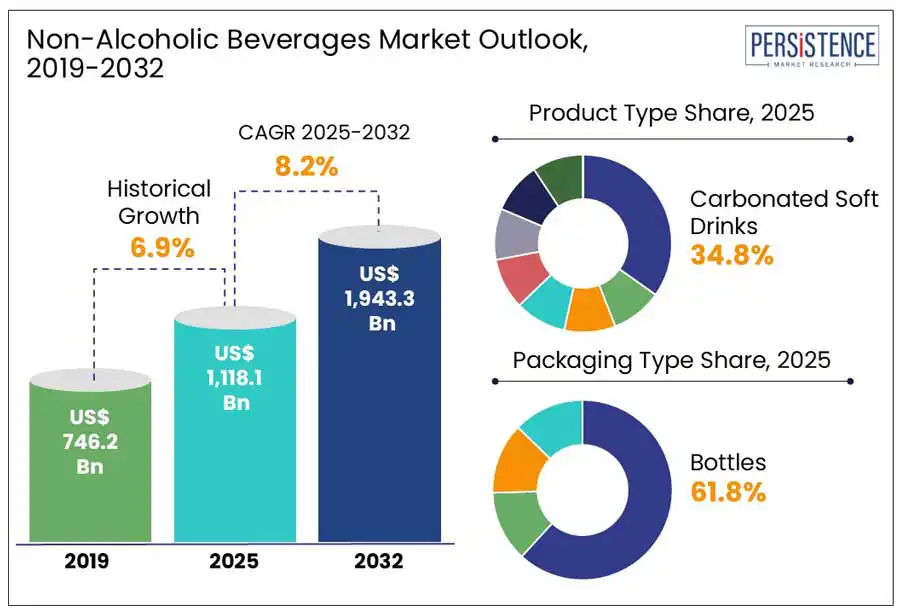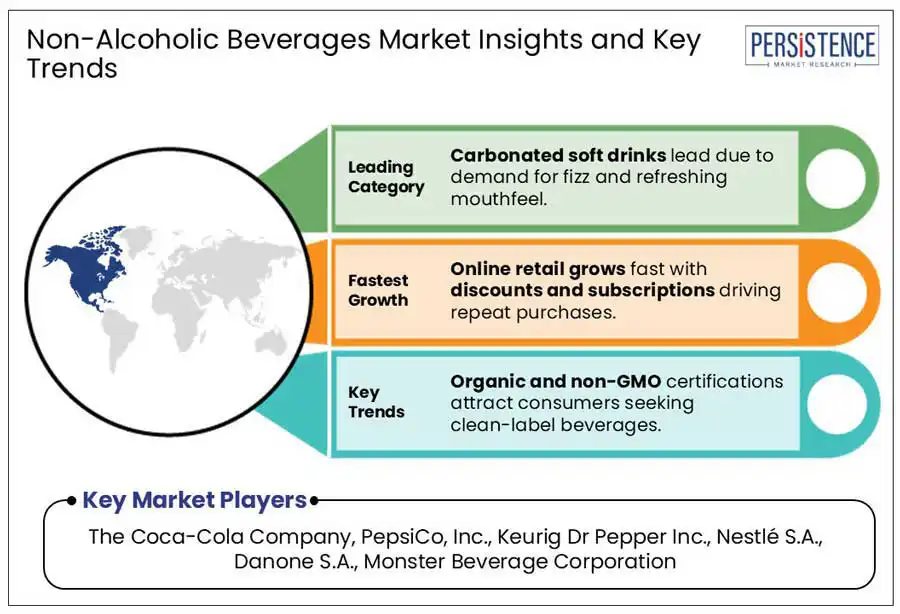ID: PMRREP18559| 210 Pages | 7 May 2025 | Format: PDF, Excel, PPT* | Food and Beverages

The global non-alcoholic beverages market size is estimated to grow from US$ 1,118.1 bn in 2025 to US$ 1,943.3 bn at a CAGR of 8.2% by 2032. According to the Persistence Market Research Report, the non-alcoholic beverages industry is experiencing strong momentum, driven by health-conscious consumer shifts, rising demand for clean-label and functional drinks, and online retail growth. Evolving lifestyles, sustainability trends, and regional innovation continue to shape the competitive landscape and future growth trajectory.

Key Industry Highlights
|
Global Market Attribute |
Key Insights |
|
Non-Alcoholic Beverages Market Size (2025E) |
US$ 1,118.1 Bn |
|
Market Value Forecast (2032F) |
US$ 1,943.3 Bn |
|
Projected Growth (CAGR 2025 to 2032) |
6.9% |
|
Historical Market Growth (CAGR 2019 to 2024) |
8.2% |
The rise of sober-curious lifestyles is significantly increasing the global demand for non-alcoholic beverages. More consumers are choosing to cut back on alcohol for health and personal reasons, leading to a shift in the beverage market. Events like Sober October and Dry July inspire alcohol-free living, raising awareness of non-alcoholic options. Campaigns such as the Irish Heart Foundation's "On the Dry" in January further encourage sobriety, transforming consumer habits. As these movements gain momentum, brands have exciting opportunities to develop innovative non-alcoholic drinks that cater to this growing market. This shift drives a wave of creativity, offering health-conscious alternatives that align with the sober-curious lifestyle.
Sugar content limitations pose a significant challenge for the non-alcoholic beverages market. As consumers grow more health-conscious and seek lower-sugar options, manufacturers face pressure to reduce sugar levels. While this shift promotes better health, it often compromises taste, making it difficult to deliver the flavor and sweetness consumers expect from traditional drinks.
To compensate, many brands turn to artificial sweeteners or natural alternatives like stevia, but these often fail to recreate the authentic experience. Striking a balance between flavor and compliance with sugar regulations is crucial. As regulatory pressures around sugar content intensify, the market faces the challenge of delivering satisfying, flavorful beverages without compromising on health-conscious ingredients, which could limit consumer appeal.
Companies in the non-alcoholic beverages market have a prime opportunity to capitalize on the growing demand for dairy-free and vegan-friendly drinks. As health-conscious consumers, particularly younger generations, increasingly seek plant-based alternatives, businesses can attract a diverse audience, including those with lactose intolerance and committed vegans.
A prime example is Zevia®, which offers beverages that are naturally sweetened with plant-based ingredients, free from artificial colors, flavors, and sweeteners. These drinks are also Non-GMO verified, making them a perfect example of how companies can leverage clean, plant-based ingredients to meet growing consumer demands in the non-alcoholic beverage sector.
Carbonated soft drinks continue to lead the non-alcoholic beverages market, driven by consumer preference for their exciting fizz and refreshing mouthfeel. The sensory appeal of carbonation, characterized by its tingling and bubbly sensation that provides a unique drinking experience that other beverages often find difficult to replicate.
According to a survey by Persistence Market Research, 76% of U.S. consumers enjoy carbonated soft drinks at least once a week, with 46% citing fizziness as their main reason for consumption, highlighting carbonation's crucial role in building loyalty. This enduring preference supports high demand across various age groups and markets, making carbonated beverages a resilient and profitable segment. As brands innovate with clean-label ingredients and lower sugar options, maintaining that signature fizzy experience is essential for attracting and retaining customers in a competitive market.
Online retail is rapidly growing as consumers are increasingly drawn to attractive discounts and convenient subscription models that encourage repeat purchases. E-commerce platforms like Amazon's "Subscribe & Save" program offer up to 15% off and free shipping on recurring orders of non-alcoholic beverages, appealing to budget-conscious shoppers. Similarly, Alibaba.com enables bulk buying with tiered pricing, allowing buyers to enjoy significant savings. These models not only enhance affordability but also simplify the replenishment process. As online platforms continue to innovate and personalize their offerings, the convenience and cost-effectiveness of online retail are set to drive significant growth in the global non-alcoholic beverages market.

North America leads the global non-alcoholic beverages market with a significant 31.2% share, driven by evolving consumer preferences and a strong industry presence. As health consciousness grows, consumers are increasingly seeking cleaner, healthier options. In Canada, the demand for clean-label beverages made from natural ingredients is rising, reflecting a broader trend toward transparency and wellness.
Meanwhile, the U.S. market continues to see robust demand for energy and sports drinks, as well as demographic-specific offerings tailored to millennials, Gen Z, and active lifestyles. The presence of key players such as PepsiCo and The Coca-Cola Company strengthens North America's leadership, as these corporations foster innovation in both functionality and flavor. The North American non-alcoholic beverage industry is likely to sustain its growing pace in the future years, because of flavor-forward innovations such exotic fruit infusions and functional blends combined with personalized marketing.
Europe non-alcoholic beverages market is evolving rapidly, driven by shifting consumer values and innovation. Studies from Persistence Market Research shows that vegan claims are the most preferred attribute in low and no-alcohol beverages, indicating a strong plant-based movement across the region. European consumers are also influenced by strict labeling regulations that promote transparency and encourage clean-label formulations. Fruit flavors, especially citrus and berry, remain highly popular due to their natural appeal. Innovation is accelerating in protein-infused ready-to-drink (RTD) coffee, which combines convenience with functional benefits.
Sustainable packaging is another critical trend, with eco-conscious consumers opting for brands that minimize environmental impact. Local sourcing and regional products are also major purchase drivers, as consumers seek authenticity and reduced carbon footprints. Leading players such as Coca-Cola Europacific Partners are aligning with this trend, targeting 100% recyclable primary packaging by 2025 to meet regulatory and consumer expectations.
From Bollywood billboards to bustling Tokyo streets, the Asia Pacific non-alcoholic beverages market is bursting with dynamic trends shaped by local preferences and cultural shifts. In India, above-the-line (ATL) marketing remains the most popular strategy for carbonated beverage brands, often enhanced by celebrity endorsements that connect with the public. The country also has a significant dairy-based beverages market, being the leading producer and consumer of milk-based drinks.
In contrast, Chinese consumers are increasingly interested in functional beverages that incorporate traditional Chinese medicine (TCM) ingredients, reflecting a strong preference for wellness through ancient remedies. In Japan, our recent study revealed that 42% of respondents do not consume alcohol, indicating a notable shift towards sobriety particularly among younger generations. This “sober curious” movement is fueled by increasing health awareness, a trend amplified during the COVID-19 pandemic, opening doors for innovative non-alcoholic drink options.
The global non-alcoholic beverages market is highly competitive, featuring several global giants alongside an increasing number of regional brands and startups. This dynamic environment is being driven by growing foreign direct investment (FDI), strategic distribution partnerships, and increased investments in sustainability initiatives. Companies are actively innovating in eco-friendly packaging and developing cleaner, healthier formulations in response to consumer demand. Additionally, government regulations particularly those targeting sugar reduction are shaping product reformulation strategies. These evolving factors, combined with rapid innovation and shifting consumer preferences, are redefining the market's direction.
The Global Non-Alcoholic Beverages market is projected to be valued at US$ 1,118.1 Bn in 2025.
The growing popularity of sober curious lifestyles is positively influencing the demand for non-alcoholic beverages.
The Global Non-Alcoholic Beverages market is expected to witness a CAGR of 8.2% between 2025 and 2032.
Companies can tap into the growing preference for dairy-free, vegan-friendly nutritional beverages, is the key market opportunity for companies in the Global Non-Alcoholic Beverages market.
Key players in the Global Non-Alcoholic Beverages industry include The Coca-Cola Company, PepsiCo, Inc., Keurig Dr Pepper Inc., Nestlé S.A., Danone S.A., Monster Beverage Corporation, and others.
|
Report Attributes |
Details |
|
Historical Data/Actuals |
2019 - 2024 |
|
Forecast Period |
2025 - 2032 |
|
Market Analysis |
Value: US$ Bn, Volume: KL |
|
Geographical Coverage |
|
|
Segmental Coverage |
|
|
Competitive Analysis |
|
|
Report Highlights |
|
|
Customization and Pricing |
Available upon request |
By Product Type
By Packaging Type
By Distribution Channel
By Region
Delivery Timelines
For more information on this report and its delivery timelines please get in touch with our sales team.
About Author